Pause carousel
Play carousel
The use of the term "equality and diversity" (E&D) is commonplace in the public and private sectors, although organisations differ in what exactly the term means. Many definitions of equality and diversity share similar elements, related to the improvement of an organisation, business or community for a common good or purpose. For Abertay equality and diversity is recognising and valuing that everyone is different, and respecting and appreciating those differences to bring about improvements for organisational and societal benefit. People with different backgrounds, experiences and attitudes bring fresh ideas and perceptions, and a diverse organisation such as that at Abertay can draw upon the widest range of experiences so it can listen to, meet, and provide for, the needs of its employees, students and the community the University serves. The University’s strategic plan 2020-25 further underlines our commitment to equality and diversity in the following statements.
Our purpose
Our guiding principles
By 2025 we will be known for
The SFC published a new set of National Equality Outcomes (NEOs) in January 2023. The University is in the process of reviewing these with a view to confirming an integrated set of equality outcomes incorporating the NEOs (as appropriate) as well as any further locally identified priorities.
This mainstreaming report sets out the key areas in which the University has progressed over the past two years and prior to the publication of the NEOs. In addition, our published Outcome Agreement (2021/22) with the SFC highlights the commitments the University has pledged itself to.
Items that have had the most beneficial impact on the University in relation to Equality and Diversity are:
The University provides mandatory equality and diversity training, including unconscious bias, in recruitment and selection, Stress management (to address issues surrounding mental well-being) and diversity in the workplace (including student placements) to underpin its commitment to ensuring good relations between people of different protected characteristics.
The continued development of the ‘lead voices’ project to harness interest and enthusiasm from among staff and students in fostering good relations among those with similar and different protected characteristics.
The University carried out biannual Staff Engagement Surveys since 2013 including comprehensive equality analysis. Responses on E&D matters have been largely very positive.
In 2020-21, the University launched a bystander module on its Virtual Learning Environment to assist students with calling out poor behaviour to foster a safe and positive campus experience. The purpose to highlight that hate crimes and discriminatory incidents against others are not acceptable behaviour – whether the incidents happen offline, or online. Additionally, the university provides students with a consent on campus module as well a staff development module on Gender Based Violence.
The University has also created The Abertay Citizen Code, an agreement between us as an institution and our student community to ensure everyone is aware of their responsibilities in creating an inclusive and welcoming University, that treats everyone equitably, fairly, and with respect. Students sign up to the code at registration.
From a teaching and learning perspective Abertay will be proactive in creating a collaborative process that enables equality, diversity and inclusion in all aspects of teaching, learning, research, operations and support as well as the wider engagement. The aim is to create a learning community that is based on a core principle of equity that supports a global staff and student base in achieving their personal and professional goals. Abertay’s vision is to create a welcoming environment where students feel belonging regardless of their backgrounds, identities or abilities[1].
The introduction of university micro-credentials for all new students supports the university in its EDI aims. ABE101 supports students to understand the expectations of being a student in higher education and about expected student behaviours in relation to equality, diversity, and inclusion.
[1] Abertay University’s Vision for Embedding EDI within the Curriculum: Building on decolonising and anti-racist approaches, Teaching and Learning Committee, March 2022
The University is a holder of the Athena SWAN bronze award. The University has also published it's Athena Swan action plan to address gender equality.
The University has hosted and contributed to numerous Dundee Women in Science events in this festival since 2014, with a view to improving the engagement of women and girls in STEM (Science, Technology, Engineering and Maths).
The University has a balanced Senior Management Team (50% female), a 60/40 (female: male) split on the University Executive and the balance on our Court has also improved with 50% of lay members being female compared to 44% in 2017.
University Court (the governing body) aims to have a diverse membership in terms of gender.
Figure I shows the trend in the gender balance across all members of Court over the past 5 academic years.
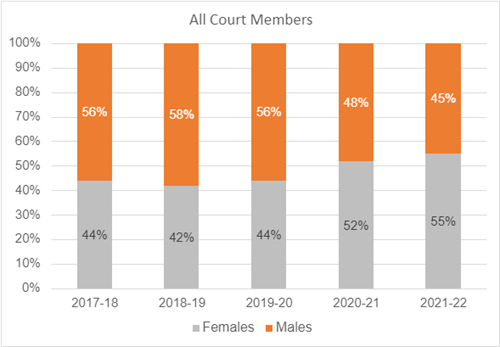
For those positions appointed by Court (i.e. the independent or lay members) Court aims to have at least 40% male or female and must have the objective, under the terms of the Gender Representation on Public Boards (Scotland) Act 2018, of having 50% women among independent members.
In session 2021-22 (see figure II) the objective of gender balance of 50%/50% was not quite met for the lay membership. In previous years meeting the objective of a balanced lay membership has been variable. Court has actively encouraged female applicants to address this objective and was successful in doing so. In addition, the overall gender breakdown for all Court members has become 55% female (see figure I), meaning there will be a majority of female members since 2020-21 for two in a row.
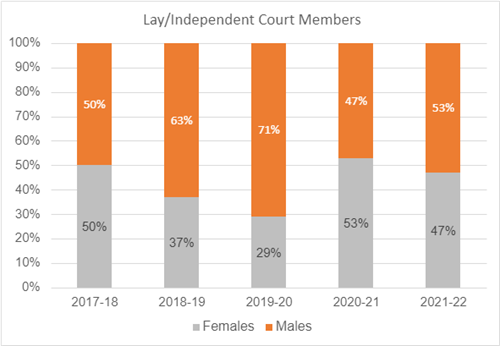
The University is committed to tackling gender-based violence. In 2019 a Short Life Working Group (SLWG) was established with students, staff and trade unions. The group has been reinstated in 2022/23 to review progress, process and procedures. The University uses the Scottish Governments Equally Safe toolkit as the framework for our GBV work.
As a result of previous work the University has established a reporting and support system; provided training to staff facilitated by Rape Crisis Scotland on how to support those reporting rape and sexual abuse; changed the process for non-academic student misconduct to align with sector guidance; commissioned and rolled out online student and staff awareness and training modules; and a ‘tell us’ campaign to raise awareness among student and staff of how to report GBV and access support. The university has also created a public information resource on GBV within the library.
The University has a balanced Senior Management Team with the University Principal being female. There has also been an improvement in the gender pay gap (see page 15).
The student population has been for many years more males than females. The gender profile of the University in this respect is different from most other Universities in Scotland who have a majority of female students (see appendix 1, figure 6a).
The University has committed to building on its Gold award[1] for the Healthy Working Lives initiative. Amongst other activities, the University has run Health Fairs and Mental Health Awareness programmes with a view to promoting good physical and mental health amongst staff and students.
The number of student counsellors employed by the university increased from 5 to 8 (1.8FTE to 3.2FTE) to take account of need. The University Counselling and Mental Health Team have worked with NHS Tayside to set up a Mental Health crisis referral route without the need to go through primary care (the first in Scotland) in 2022.
The percentage of disabled students enrolled at the University has increased from 11.1 in 2013-14 to 19.0% in 2022-23 (see appendix 1, figure 2a).
The University has partnered with AccessAble to create detailed guides so disabled people and their carers can work out the accessibility of buildings and local areas in advance. Working with the disabled community, the University established that providing information about the accessibility of the campus gave disabled people greater independence when planning to come to the University.
The University has published and committed to a BSL Action Plan 2018-2024.
[1] Award scheme run by Public Health Scotland no longer running.
Our commitment to equality and diversity was recognised in 2016 when we were the first university in Scotland to be awarded the Race Equality Charter Mark Bronze Award. The University was successful in 2021 in its renewal of the award (the only university in Scotland to do so). The University is one of 38 Universities in the UK to achieve this accolade. As part of the application process, we developed a race equality action plan, which is now being embedded into our overall Equality Action Plan, and which we will continue to implement.
As part of the University quality enhancement activities, all divisions have provided case studies to highlight good practice in embedding Race Equality in the curriculum. The AbLE academy (the Teaching and Learning division at the University) are using the information to support the Universities approach to improving the teaching and learning environment.
Additionally, Abertay aims to be a proactive and engaging partner with Dundee and beyond to create a teaching, learning and engagement practice that is equitable to all its stakeholders. Our project on EDI in the curriculum will start its focus internally but extend to include its various external partners who both contribute to and benefit from an engagement with Abertay.
The internal work will be focused on three ambitions:
The University also promotes the module ‘Union Black: Britain’s Black cultures & steps to anti-racism' organised by Santander Universities UK in partnership with the Open University. Developed in response to Universities UK’s ‘Tackling racial harassment in higher education’ report, the course has been designed to drive cultural change across the higher education sector. There is a one-hour introductory course alongside the full content, which include a mixture of videos, discussion forums, reading materials and interactive activities.
The University provides a multi-faith space, accessible to all who wish to use its facilities (students and staff), supported by honorary Chaplains, Imams and rabbis who provide support within the local community on a voluntary basis.
The University is committed to ensuring that Trans and Non-Binary Students are treated with dignity and respect and receive appropriate support. To this end, the University has developed Gender Identity policies and protocols for staff and students.
The University and Abertay SA support the Dundee Pride event. Over 100 staff and students took part in the recent parade representing the University and its LGBT+ community.
Part of the University’s mission to widening access relates to ‘mature learners’. The number of students aged 25 and over has increased since 2014-15 from 644 to 980 in 2022-23, a 52% increase [see figure 1].
The University has a Flexible Working Policy, which recognises the importance for employees of achieving a balance between work and family commitments. In addition, the University has Adoption and Shared Parental Leave Policies, both of which provide for pay and benefits similar to those for Maternity Leave.
The University has developed a Pregnancy and Maternity protocol for students. The purpose is to discuss the potential impact of pregnancy and maternity on an individual’s learning at University, including attending lectures and tutorials, placements, and participating in assessments and examinations. The outcome of the discussions will be the production of a plan and a risk assessment to support the student with continued learning and engagement with their academic studies.
The University’s has developed a policy and guidance to underline its commitment to ensuring that Trans employees are treated with dignity and respect and are not disadvantaged in the workplace.
The policy sets out the steps the University takes to welcome and support Trans employees and prevent discrimination. The policy covers all employees, contractors, temporary workers and job applicants and applies to all stages of the employment relationship.
In addition, the University has developed a protocol to support the needs of Trans students. This includes having a named contact to ensure continuity of support.
Developing and sustaining an inclusive and supportive culture, welcoming and retaining students and staff from a diverse range of backgrounds.
Aim 1: Implement and sustain the ‘lead voices’ project to encourage and support staff and students who identify with particular protected characteristics to garner information and opinions and to consider the implications of University policies and procedures on their protected characteristic as well as on intersectional issues.
Outcome: Project is currently on track with staff volunteering to become ‘lead voices’. ‘Lead voices’ have been helpful in reaching out to those with protected characteristics to assist in obtaining feedback during the drafting process for new or updated policies and protocols. This in turn has assisted the University in its obligations regarding Equality Impact Assessments.
Lead voices have curated 2 university wide ‘Diversity fests’ in 2021 and 2022. These weeklong events of Equality, Diversity and Inclusion talks and activities delivered by staff and students at the university were anchored by keynote talk from an honorary graduate. The keynote talks in 2021 and 2022 were Peter Tatchell ‘Fighting for justice: how the US Black Movement influenced the struggle for LGBT+ freedom’ and Professor Laura Serrant ‘On leadership, legacy…and finding my Voice’.
Aim 2: To ensure equitable admissions to all programmes of study.
Outcome: The University remains committed to promoting a fair admissions policy ensuring that we give equal consideration to applicants who apply on time, and who possess the necessary knowledge and skills, regardless of the route taken during their senior phase of studies. Building on our experience of using ‘contextual offers’ over many years, Abertay introduced the criteria in November 2016 with around 5% of new entrants enrolling at the University who would not otherwise have been offer a place.
Aim 3: To endeavour that, by 2030, no academic subject area has an extreme gender imbalance (75: 25) – in line with the Scottish Funding Council Outcome relating to Scottish domiciled undergraduate students.
Outcome: In 2022-23, 11 subject areas out of 18 have gender imbalances (highlighted in red). This an increase of 2 from the previous year (2021-22). Although there is a steady improvement in the gender balance for Mental Health Nursing.

The University continues with its outreach activities to address gender stereotyping in relation to subject choices (see aim 4 for details).
Aim 4: To engage with local schools to tackle gender imbalance earlier and to tackle gender stereotypes.
Outcome: The University staff facilitate school visits to deliver workshops within local schools, particularly in subject areas with a poor gender balance. During COVID these visits were suspended until recently. The University uses current students as part of the outreach work to provide school students with positive role models they can better relate to and be enthused by.
The University also works with Equate Scotland to support and encourage women (young and old) into STEM subjects.
The University also has an ESRC-funded project exploring the educational applications of self-reference effects. This includes examining the early development of self-biases, the effects of self-cues on attention and working memory, and the impact of clinical disorders on self-processing.
Aim 5: To enhance retention and completion at a subject level where there is a statistically significant gap by gender.
The University has developing its learner analytics tools (using among other elements, attendance, VLE and assessment completions) to support retention. This has allowed professional services staff to identify (with a RAG system) students disengaging with their studies; contact students via email, phone and/or text; and implement a series of interventions. In 2021-22 the university also employed a Student Success Officer for each academic school to reach out to students identified as having poor engagement to offer support and guidance on re-engaging with their studies.
Aim 6: Maintain the institutional Athena Swan award.
Outcome: The University was successful in achieving the Athena Swan Bronze award in November 2018 and has an action plan related to it.
Aim 7: Provide leadership development and mentoring for women through Aurora and other programmes to lessen the gap between men and women in senior positions within the University.
Outcome: The University is providing female academic staff with the opportunity to participate in the TRAM mentoring scheme (a cross-institutional collaboration of seven higher education (HE)/research institutions in Scotland and Ireland). Academic staff can be mentors as well as mentees. In 2021-22 there were eight mentees (4F, 4M) and 12 mentors (6F, 6M) from Abertay (three of whom were both mentors and mentees). The University supports staff to participate in the Aurora leadership development initiative for women in HE. Abertay has supported a cohort of participants, including both academic and professional services staff, every year since 2015. There were four delegates in 2021-22 and three in 2022-23. The University also provides a range leadership development for the Senior Management Team, including supporting two women and one man to complete the flagship Advance HE Vice-Chancellor Transition and Top Management Programmes in 2022-23.
Aim 8: Create a barrier free campus for disabled people.
Outcome: The University carried out an access audit of the estate in 2019. Details of the University’s accessibility can be found here.
Aim 9: Invest in high quality infrastructure to provide an environment which will support and inspire our students and staff.
Outcome: The University is currently engaged in envisioning its estate to provide facilities that are accessible and improve the teaching and learning environment.
Aim 10: Develop a BSL action plan by 2018 in consultation with Deaf and hard-of-hearing staff, students and the local community.
Outcome: The University has developed a BSL action plan 2018-2024.
Aim 11: Continue to address issues surrounding individual perceptions of declaring mental health issues for staff and students.
Outcome: Since 2014-15, there has been a near fivefold increase in the number of students declaring a mental health condition on enrolment from 50 to 233 in 2022-23. As a result the University has invested in the Student Counselling and Mental Health Service, increasing the staffing complement for 2.3FTE (2018-19) to 3.5FTE (2021-22). This increase in staff has provided an additional 1000 hours of available appointments to the student community.
The Student Counselling and Mental Health Service and staff occupational health advisor work together to provide a coordinated voice and messages on World Mental Health day and other key times to promote services and support.
The University has a staff counselling service and occupational health advisor to support its staff with Mental Health concerns. A wide range of resources, guidance and sources of further information is provided for staff on the intranet. In addition, there are frequent mental health promotion activities, such as Mental Health Awareness Week events; stalls at the biennial staff health fair; and publicising ‘Time to Talk Day’.
Aim 12: Improve the records held on disability for staff to enable meaningful analysis and identification of priorities for action.
The proportion of staff known to be disabled has increased by over 40% in the last four years, rising from 4.6% to 6.6%. Data is requested as part of recruitment and onboarding, when there is an introduction to our Occupational Health Adviser providing guidance on requesting support if required. People Services regularly ask individuals to ensure their data is correct and up-to-date. In addition, equality analysis is undertaken of staff engagement survey responses. In the 2022 survey, responses from disabled staff were less positive than from staff as a whole. This analysis informed the new People Strategy (approved in November 2022), which includes a strategic objective to undertake a comprehensive disability self-assessment to identify challenges and priorities for action.
Aim 13: Improve employment outcomes for disabled students so that they are the same as their nondisabled counterparts by 2021.
Outcome:
Upon reviewing the data on disabled students the university careers service identified that neuro-divergent students (i.e. those with ASD) were less likely to be in employment or in graduate employment compared to other disabled students or non disabled students. The careers service undertook a pilot project entitled ‘Thinking differently’ to support, advise and guide neuro-divergent students into employment. The University Careers Service offers tailored support to assist autistic students' progression to employment.
The University continues to offer career guidance and career development related opportunities support all disabled students access the graduate jobs market.
Aim 14: Ensure that our student profile reflects the wider community within which the University sits and maintain a disabled student population of 14% for the next four years.
Outcome: Achieved. Since 2018-19 (see figure 2a) the university has had an increased in the percentage of students with a declared disability. In 2022-23 the percentage was 19.0% of the students population declared a disability.
Aim 15: Implementation of the Race Equality action plan by 2024/25.
Outcome: The university was successful in its Race Equality Charter Mark renewal. As a result, a new action plan has been produced.
Aim 16: Improve employment outcomes for BAME[1] (Black Asian and Minority Ethnic) students so that they are the same as their white counterparts by 2021.
[1] The university acknowledges that BAME is a contested term to describe the heritage of people from Black, Asian and Minority Ethnic backgrounds.
Outcome: The University has a small BAME student population. As a result three years data has been aggregated to provide a large enough sample to provide statistical robust data. It is not possible to disaggregate BAME data as numbers are very small for each ethnic background (one’s and two’s) without potentiality breaching General Data Protection regulations (GDPR). In 2019/20 there were 310 BAME students at the University (7.8% of the student population). The number of BAME graduating students responding to the survey on graduate destinations was, between 2016-17 to 2018/19, proportionate to the size of the population. These are the most up to date figures at the time of publishing the mainstreaming report.
|
Numbers and percentage of respondents to Graduate Outcome survey 2016/17 to 2018/19 by Ethnicity |
BAME |
White |
||
|
133 |
7.3% |
1701 |
92.7% |
The aggregated graduate outcomes data 2016/17 to 2018/19 shows that the percentage of BAME students in employment is 6.3% less than their white counterparts over the 3-year period. Although employment rates for BAME and white students are substantially higher than the Dundee City figures (65%) for 2019[1]. BAME graduates when compared to the Scottish University average[2] (64-65%[3]) at Abertay are more likely to be in employment (74.4%). Of note is that BAME graduates at Abertay are more likely to be in further study (4.2% higher) than their white counterparts over the 2016/17 to 2019/20 period.
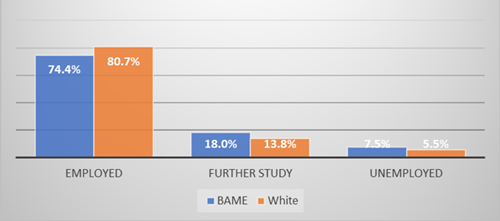
The percentage of BAME graduates over the 3-year period who are unemployed is 7.5% compared to 5.5% for their white counterparts. Unemployment rates in Dundee[4] in 2019 were 5.7%. Therefore, BAME graduates were more likely to be unemployed than their white counterparts, although not significantly so, it was above the Dundee city percentage. When compared to the Scotland range (4% to 9%) for BAME graduates[5] the figure at Abertay sits within it.
In terms of Graduate level employment BAME graduates are more likely to be in professional and managerial roles compared to their white counterparts over the 2016/17 to 2018/19 period.
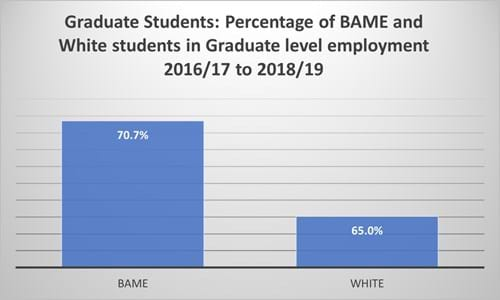
Aim 17: Embedding Race Equality within the curriculum by identifying at least one case study of good practice per academic division.
Outcome: Completed. These case studies are hosted on the University AbLE academy intranet pages. There have been AbLE seminars in 2019 and 2020 to highlight good practice to the wider University teaching community in related to embedding race equality within the curriculum (decolonising the curriculum). The case studies formed part of the successful renewal application in 2021/22.
[1] https://www.thecourier.co.uk/fp/news/local/dundee/816821/dundee-has-second-highest-unemployment-rate-of-any-british-city/
[2] https://www.hesa.ac.uk/data-and-analysis/graduates/activities (Full and part time employment)
[3] Range for Black, Asian and Minority Ethnic groups
[4] http://www.nomisweb.co.uk/reports/lmp/la/1946157411/printable.aspx
[5] https://www.hesa.ac.uk/data-and-analysis/graduates/activities
Aim 18: Increased provision of information for Trans staff and students.
Outcome: The University has published ‘Guidance for Trans Staff’ and a ‘Gender Identity Protocol for Students’. Both were reviewed and commented on by those who identify as trans to ensure support and guidance address the needs of this community.
Aim 19: Improve the representation, progression and success of LGBT+ staff and students.
Outcomes: The development of the ‘Lead Voices’ has provided an opportunity for the LGBT+ community to highlight concerns. It was recently announced that one of the LGBT+ lead voices will set up an LGBT+ staff network. This will assist in identifying further measures to ensure long term sustainable equality outcomes for the LGBT+ community.
The University has also provided an online training module to raise awareness among staff related to Transgender/Non-binary people.
Aim 20: Increased provision of ‘all gender’ or ‘gender neutral’ bathroom facilities on campus.
Outcome: In progress
Aim 21: Greater partnership working between University support services and the LGBT+ community, particularly around mental health.
Outcome: The University Counselling and Mental Health Service has worked with the LGBT+ society to produce online information addressing a range of issues including mental health. The staff continue to work with the LGBT+ society to identify areas where they can work collaboratively.
Aim 22: Continue to provide a modern fit for purpose service for staff and students that reflects the needs of the University and the community within it sits.
Outcome: The University continues to engage with a range of faiths and religions in Dundee. This includes the community providing honorary chaplains, imams and rabbis to address the faith needs of staff and students.
Aim 23: Provision of multi–faith facilities and contemplation space for those with no faith or belief.
Outcome: The University provides and multi faith space that can be booked by any faith. There are also Islamic prayer rooms with washing facilities and a contemplation room for all faiths and none.
Aim 24: Improve the retention of ‘mature’ students to that of younger students.
Outcome: Based on data from HESA, in 2019-20 the percentage of mature learners continuing was 85.4% (an improvement of 4.4% compared to 2018-19) compared to 92.4% of young learners. This is significantly below benchmark. The University has set up a retention working group, in 2020, to establish what the University can do to address and reverse the trend of mature learners non-continuation beyond their first year of study. The work of this group continues.
Aim 25: Improve support for staff and students before, during and after maternity/adoption/parental leave.
Outcome: The University has developed a Pregnancy and Maternity protocol for students. This identifies a named contact whose role is to develop a support plan before, during and after maternity/adoption/parental leave. In addition, the University funded a small research project to further understand the needs of students before, during and after maternity/adoption/parental leave. One success of these two developments is staff have formed a support network for those who are pregnant or returning to work or their studies.
Lead Voices for Pregnancy and Maternity is an established group providing a network and voice for staff, which has been expanded to include staff who are carers.
Aim 26: Include the needs of pregnant staff and maternity/adoption/parental leave returners in the Sabbatical Leave Policy and mentoring provision.
Outcome: In progress. The Sabbatical Leave Policy specifically focuses on this group, stating that particular consideration will be given to applications for sabbatical leave following a period of maternity/adoption or parental leave to help re-establish the employee’s career. It states, too, that sabbatical leave may also be granted as a form of positive action to promote career development for under-represented groups. The University provides mentoring through the TRAM scheme for academic staff and mentors are provided for those undertaking the PG Certificate in Academic Practice and the Aurora women’s leadership programme. The TRAM scheme encourages both mentors and mentees to indicate their experience and interests, including career break management and work-life balance. Similarly Aurora participants are matched with mentors to suit their particular areas of focus.
The overall gender pay gap at the University has decreased from 13.7% in 2019 to 11.6% in 2022, although it was narrower in 2020 and 2021 (at 9.6% and 11.4% respectively). There are no significant gaps within grades, indicating that the reason for this pay gap is vertical occupational segregation i.e. the higher proportion of women in the lower paid jobs and the higher proportion of men in higher paid jobs. It should be noted that the University does not outsource cleaning, catering or similar services, so the full range of staff, and the associated vertical occupational segregation, are reflected in the overall pay gap figure.
The University has developed robust performance, development and reward policies and procedures to underpin equitable and fair pay for all university staff. The University’s pay and grading structures are underpinned by a systematic and analytical approach to job evaluation, using industry standard tools. These are designed to measure the relative value of roles in a transparent, consistent and fair way.
The University is committed to undertaking further work to address the gender pay gap. In particular, this is through the Athena Swan charter framework for the promotion of gender equality in Higher Education.
|
|
2019 |
|
2020 |
|||||||
|
|
Female |
Male |
|
Female |
Male |
|
||||
|
No. |
Average FTE salary |
No. |
Average FTE salary |
Pay gap |
No. |
Average FTE salary |
No. |
Average FTE salary |
Pay gap |
|
|
All |
363 |
£30,623 |
307 |
£35,384 |
13.5% |
295 |
£34,323 |
274 |
£37,978 |
9.6% |
|
Median FTE salary |
|
£27,025 |
|
£31,302 |
13.7% |
|
£31,866 |
|
£33,797 |
5.7% |
||||||||||
|
|
2021 |
2022 |
||||||||||||||||||
|
|
Female |
Male |
|
Female |
Male |
|
||||||||||||||
|
No. |
Average FTE salary |
No. |
Average FTE salary |
Pay gap |
No. |
Average FTE salary |
No. |
Average FTE salary |
Pay gap |
|||||||||||
|
All |
296 |
£33,453 |
271 |
£37,770 |
11.4% |
317 |
£33,982 |
287 |
£38,423 |
11.6% |
||||||||||
|
Median FTE salary |
|
£31,866 |
|
£32,817 |
2.9% |
|
£32,344 |
|
£34,304 |
5.7% |
From 2019 to 2021 BAME staff were on average paid higher than white staff, based on both mean and median salary. This pay gap was a result of a larger proportion of BAME staff in higher paid academic roles. This has changed in 2022, when the average BAME staff salary was slightly less than white staff, although the median pay of BAME staff remains substantially higher than white. There has been a large increase in BAME staff since 2021 (from 31 to 46). Five of these were current Abertay students, employed as Student Event Helpers. As this role is a Grade 1, the average salary for BAME staff has been lowered compared to previous years.
|
|
2019 |
2020 |
||||||||
|
|
BAME |
White |
|
BAME |
White |
|
||||
|
|
No. |
FTE salary |
No. |
FTE salary |
Pay gap |
No. |
FTE salary |
No. |
FTE salary |
Pay gap |
|
Average salary |
39 |
£34,260 |
583 |
£33,667 |
-1.8% |
30 |
£38,803 |
501 |
£36,409 |
-6.6% |
|
Median salary |
39 |
£32,236 |
583 |
£30,395 |
-6.1% |
30 |
£35,845 |
501 |
£32,817 |
-9.2% |
|
|
2021 |
2022 |
||||||||
|
|
BAME |
White |
|
BAME |
White |
|
||||
|
|
No. |
FTE salary |
No. |
FTE salary |
Pay gap |
No. |
FTE salary |
No. |
FTE salary |
Pay gap |
|
Average salary |
31 |
£37,628 |
500 |
£35,981 |
-4.6% |
46 |
£36,013 |
523 |
£36,464 |
1.2% |
|
Median salary |
31 |
£38,017 |
500 |
£32,817 |
-15.8% |
46 |
£36,382 |
523 |
£33,309 |
-9.2% |
The disability pay gap reflects those staff who have declared a disability. The pay gap shows that disabled staff were paid an average 11.1% less than their non-disabled counterparts in July 2022.
However, disabled staff were paid more in 2020 and 2021 and the figures across the four years show wide variation. The degree of fluctuation in the figures reflects the relatively low number of staff declaring a disability and suggest that there is no particular pattern of employment of disabled staff. It is not possible to draw any conclusions from these data, but the University will continue to monitor the position.
|
|
2019 |
|
2020 |
||||||||
|
|
Disabled |
Not known to be disabled |
|
|
Disabled |
Not known to be disabled |
|
||||
|
|
No. |
FTE salary |
No. |
FTE salary |
Pay gap |
No. |
|
FTE salary |
No. |
FTE salary |
Pay gap |
|
Average salary |
37 |
£30,026 |
633 |
£32,967 |
8.9% |
23 |
|
£38,701 |
546 |
£35,973 |
-7.6% |
|
Median salary |
37 |
£23,334 |
633 |
£28,660 |
18.6% |
23 |
|
£32,817 |
546 |
£32,817 |
0.0% |
|
|
2021 |
2022 |
||||||||
|
|
Disabled |
Not known to be disabled |
|
Disabled |
Not known to be disabled |
|
||||
|
|
No. |
FTE salary |
No. |
FTE salary |
Pay gap |
No. |
FTE salary |
No. |
FTE salary |
Pay gap |
|
Average salary |
30 |
£35,780 |
537 |
£35,502 |
-0.8% |
45 |
£32,364 |
559 |
£36,392 |
11.1% |
|
Median salary |
30 |
£32,342 |
537 |
£32,817 |
1.4% |
45 |
£27,924 |
559 |
£33,309 |
16.2% |
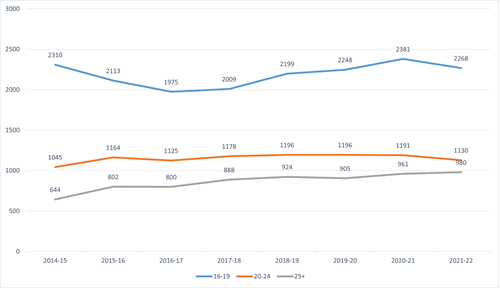
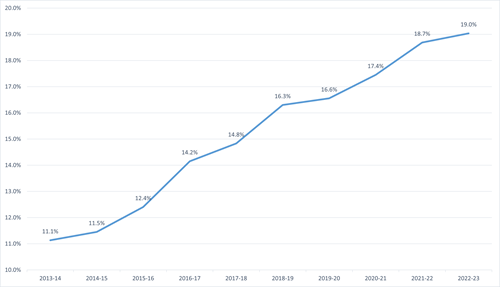
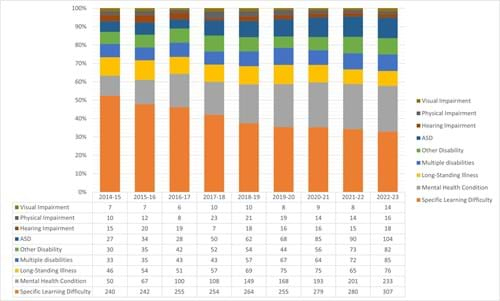
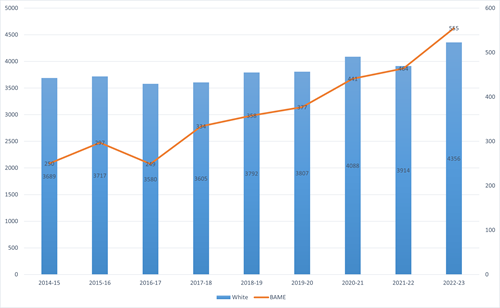



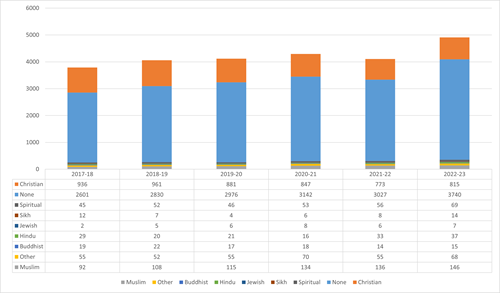

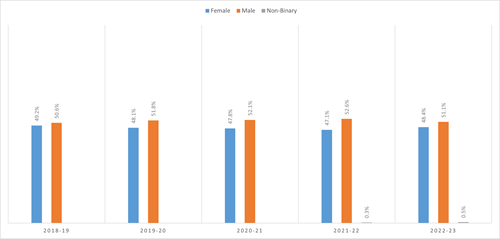
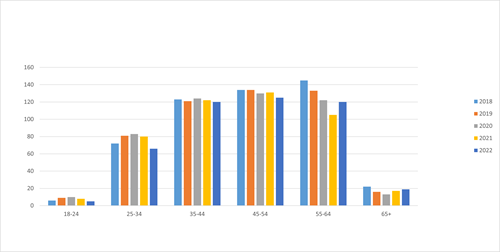
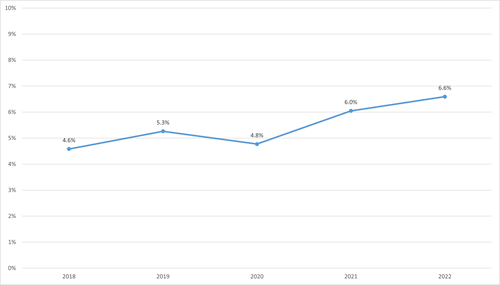
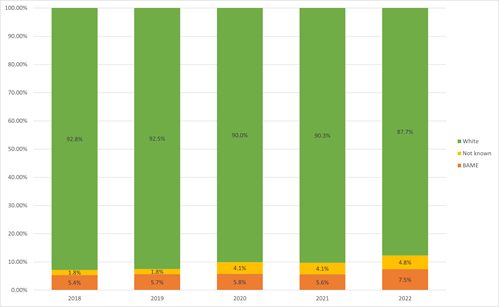
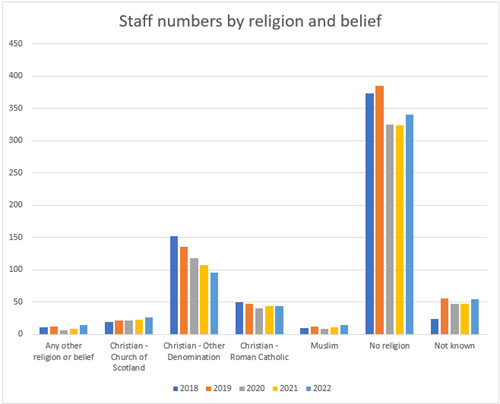
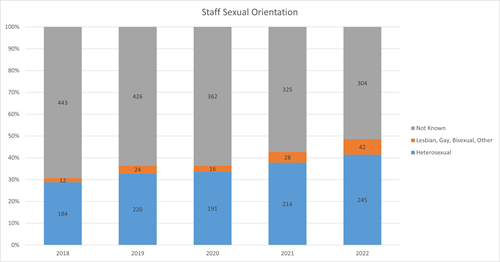
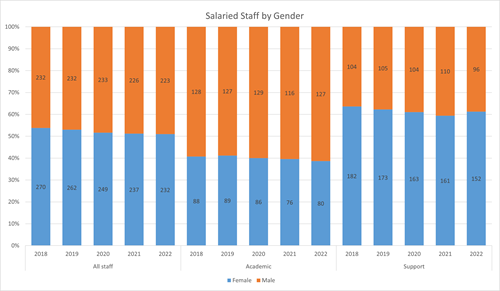
Developing and sustaining an inclusive and supportive culture, welcoming and retaining students and staff from a diverse range of backgrounds.
Aim 1: Implement and sustain the ‘lead voices’ to encourage and support staff and students who identify with particular protected characteristics to garner information and opinions and to consider the implications of University policies and procedures on their protected characteristic as well as on intersectional issues.
Aim 2: Ensure equitable admissions and attainment outcomes for all programmes of study.
Aim 3: To endeavour that, by 2030, no academic subject area has an extreme gender imbalance (75: 25) – in line with the Scottish Funding Council Outcome relating to Scottish domiciled undergraduate students.
Aim 4: To engage with local schools to tackle gender imbalance earlier and to tackle gender stereotypes.
Aim 5: To enhance retention and completion at a subject level where there is a statistically significant gap by gender.
Aim 6: Maintain the institutional Athena Swan award.
Aim 7: Provide leadership development and mentoring for women through Aurora and other programmes to lessen the gap between men and women in senior positions within the University.
Aim 8: Create a barrier free campus for disabled people.
Aim 9: Invest in high quality infrastructure to provide an environment which will support and inspire our students and staff.
Aim 10: Develop a BSL action plan by 2018 in consultation with Deaf and hard-of-hearing staff, students and the local community.
Aim 11: Continue to address issues surrounding individual perceptions of declaring mental health issues for staff and students.
Aim 12: Improve the records held on disability for staff to enable meaningful analysis and identification of priorities for action.
Aim 13: Improve employment outcomes for disabled students so that they are the same as their nondisabled counterparts by 2021.
Aim 14: Ensure that our student profile reflects the wider community within which the University sits and maintain a disabled student population of 14% for the next four years.
Aim 15: Implementation of the Race Equality action plan by 2024/25.
Aim 16: Improve employment outcomes for BAME students so that they are the same as their white counterparts by 2021.
Aim 17: Embedding Race Equality within the curriculum by identifying at least one case study of good practice per academic division.
Aim 18: Increased provision of information for ‘Trans’ staff and students.
Aim 19: Improve the representation, progression and success of LGBT+ staff and students.
Aim 20: Increased provision of ‘all gender’ or ‘gender neutral’ bathroom facilities on campus.
Aim 21: Greater partnership working between University support services and the LGBT+ community, particularly around mental health.
Aim 22: Continue to provide a modern fit for purpose service for staff and students that reflects the needs of the University and the community within it sits.
Aim 23: Provision of multi–faith facilities and contemplation space for those with no faith or belief.
Age
Aim 24: Improve the retention of ‘mature’ students to that of younger students.
Aim 25: Improve support for staff and students before, during and after maternity/adoption/parental leave.
Aim 26: Include the needs of pregnant staff and maternity/adoption/parental leave returners in the Sabbatical Leave Policy and mentoring provision.